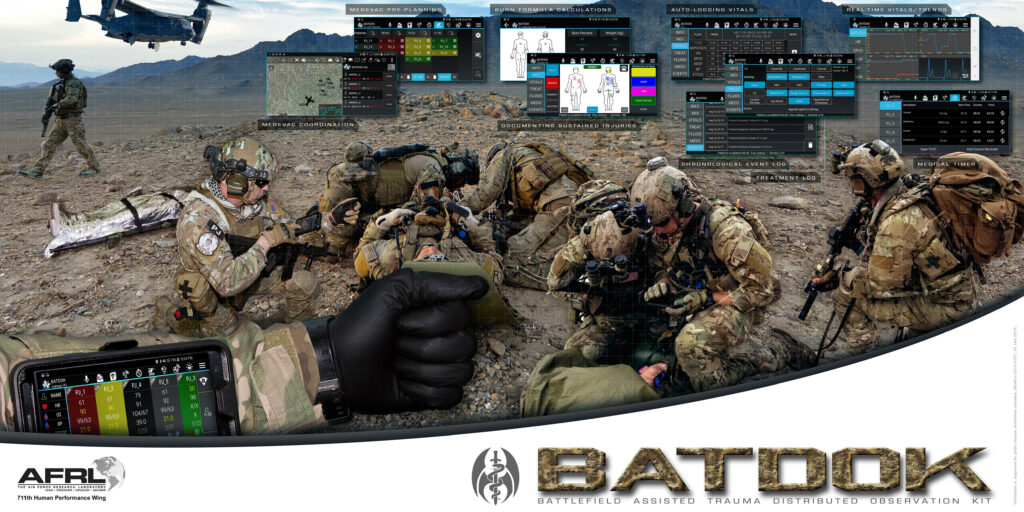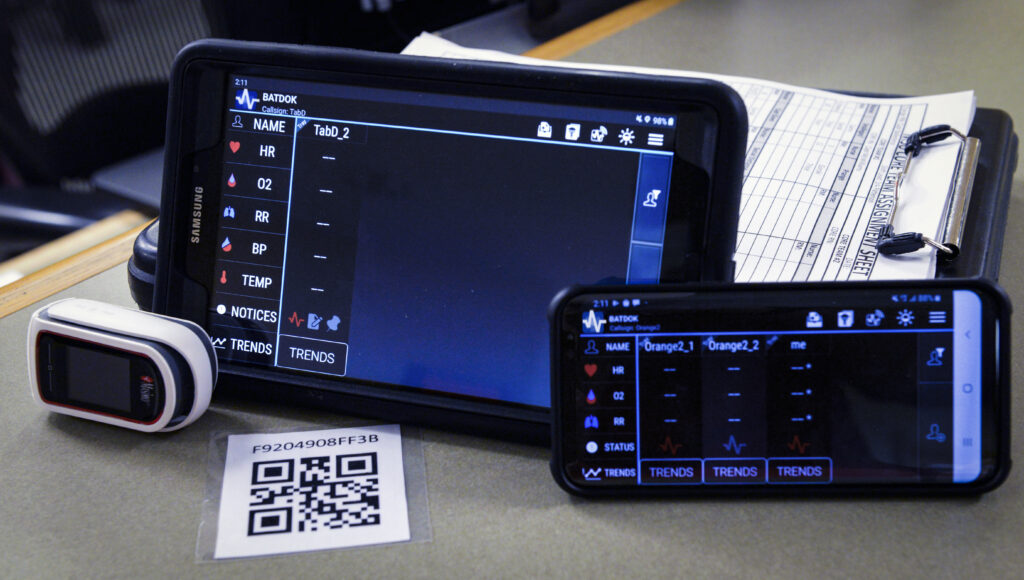WRIGHT-PATTERSON AIR FORCE BASE, OHIO (AFRL) — A mobile medical documentation tool developed by Air Force Research Laboratory, or AFRL, researchers, has been selected as the joint integrated electronic health record for point-of-injury and en route care by the Joint Operational Medicine Information Systems, or JOMIS. Following this announcement at the July 2022 Defense Health Information Technology Symposium in Orlando, Florida, demand for demonstrations of the Battlefield Assisted Trauma Distributed Observation Kit, or BATDOK, increased tenfold among military agencies.
“We’ve witnessed a big uptick in BATDOK’s inclusion and adoption into various joint exercises,” said Dr. Gregory Burnett, lead engineer for the product development branch, AFRL’s 711th Human Performance Wing. “Each of the services is layering BATDOK into their pipelines and overarching planning strategy for modernizing operational medicine.”

U.S. Airmen assigned to the 354th and 673rd Medical Group use a Battlefield Assisted Trauma Distributed Observation Kit (BATDOK) during a Capabilities-Based Assessment at the Yukon Training Area, Sept. 14, 2021. The BATDOK is a real-time, multi-patient health status monitoring and documentation tool used to integrate patient data into their health records and helps identify exact locations of casualties. (U.S. Air Force photo by Airman 1st Class Jose Miguel T. Tamondong)
Prior to BATDOK’s selection, the 711 HPW team led roughly two operational exercises per year. After the announcement, they began averaging two exercises per month. As of 2023, BATDOK, a smartphone application that replaces pen and paper records, has been provided for evaluation and testing to all the Department of Defense services, Burnett said. BATDOK has also been tested by allied forces in the United Kingdom, Morocco and Australia.
BATDOK’s selection by JOMIS, a program management office within Defense Healthcare Management Systems, is a testament to the team’s capability development work and testing with end users, Burnett said. JOMIS collects operational medicine requirements from the various services and provides medical information technology for military operations.
“AFRL developed a robust operational medicine tool that has been widely acknowledged by medical commanders as the future of information technology in combat point-of-injury medicine,” said Sandra McIntyre, JOMIS program manager. “JOMIS is proud to make BATDOK a primary product in our operational medicine care delivery platform.”
Originally started as an Air Force science and technology initiative in response to an Air Combat Command need for improved battlefield documentation, BATDOK later became a Defense Health Program initiative with funding from Air Force Medical Services. Military medics began evaluating BATDOK in 2016, and the tool deployed operationally in 2019.
“BATDOK takes the burden off the medical provider to establish and manage the wireless sensor connection and process that metadata,” Burnett said. “It just autonomously documents so [medical providers] can perform the number one mission of caring for casualties.”

BATDOK captures medical documentation to include injury types and the treatment provided to the warfighter. To document their observations and actions, medical providers simply touch buttons on a smartphone.
“BATDOK really is an intuitive tool that takes very minimal training to do the basic functions,” said Mike Sedillo, a program analyst and instructor with AFRL’s 711th Human Performance Wing.
He credits the intuitive nature of BATDOK to feedback received from end users during years of testing.
“It was this constant great relationship with the warfighter that continued to help develop BATDOK,” Sedillo said. “We brought it to various communities, and they offered suggestions.”

The Battlefield Assisted Trauma Distributed Observation Kit, or BATDOK, is software that runs on a smartphone or mobile device that can collect real-time patient information from a variety of sensors at the point of injury. The software makes it easier for the deployed medic to document vitals, help administer critical care, integrate patient data, and identify exact location of casualties in austere combat environments. (U.S. Air Force graphic)
“From the onset of BATDOK, we’ve always looked to the joint forces because medical care is not just tied to one service,” Burnett said. “As a casualty is injured on the battlefield, they move through the care continuum and that, at times, represents all the services.”
Today’s BATDOK has various modes to accommodate the medical provider’s progress and the patient’s needs. The team continues to develop the tool by incorporating additional requirements and even provides an updated version of the BATDOK application every two weeks.
“Every button, menu and look of BATDOK has been designed with the joint community’s involvement and end user input,” Burnett said. “This has allowed us to increase the user acceptance as well as its intuitive nature.”
Burnett said combat medics, ground surgical teams and even transport personnel provided valuable input for refining and expanding BATDOK’s capabilities.

Various interfaces, sensors and codes that enable the Battlefield Assisted Trauma Distributed Observation Kit, or BATDOK, are displayed at Wright-Patterson Air Force Base, Ohio, April 28, 2020. BATDOK, a mobile medical documentation tool developed by Air Force Research Laboratory researchers, was recently selected as the joint integrated electronic health record for point-of-injury and en route care by Joint Operational Medicine Information Systems, an office that provides medical information technology for military operations. (U.S. Air Force photo / Wesley Farnsworth)
While the BATDOK capability was developed within the 711th Human Performance Wing’s Human Effectiveness Directorate, the United States School of Aerospace Medicine, or USAFSAM, also provided support. The BATDOK team engaged with USAFSAM aeromedical evacuation cadre from the schoolhouse to explore ideas and learn about medical documentation needs.
“Having the [Human Effectiveness Directorate] co-located [with USAFSAM] in the wing was a huge benefit,” Burnett said. “The wing has many great thinkers and operational users. This unique combination enabled [the BATDOK team] to explore how to reduce the cognitive workload while optimizing operational mission by engaging with varied subject matter experts.”
The 711 HPW team said the goal of BATDOK is simple: support medical providers and help bring warfighters home.
“We’re dedicated to making someone else’s job easier who is facing the chaos of war,” Burnett said. “With BATDOK, we are providing [medical providers] with a tool that assists in performing the most critical mission: making sure our service members come home alive.”

About AFRL
The Air Force Research Laboratory is the primary scientific research and development center for the Department of the Air Force. AFRL plays an integral role in leading the discovery, development and integration of affordable warfighting technologies for our air, space and cyberspace force. With a workforce of more than 11,500 across nine technology areas and 40 other operations across the globe, AFRL provides a diverse portfolio of science and technology ranging from fundamental to advanced research and technology development. For more information, visit www.afresearchlab.com.
